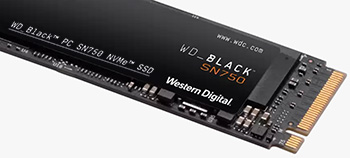Tip #1598: What is an NVMe SSD?
… for Codecs & Media
Tip #1598: What is an NVMe SSD?
Larry Jordan – LarryJordan.com
NVMe is the technology behind the fastest SSDs available today.


[ The information in this tip is from a Western Digital blog. ]
NVMe (Non-Volatile Memory Express) is a new protocol for accessing high-speed storage media that brings many advantages compared to legacy protocols. But what is NVMe and why is it important for data-driven businesses?
The first flash-based SSDs leveraged legacy SATA/SAS physical interfaces, protocols, and form factors to minimize changes in the existing hard drive (HDD)-based enterprise server/ storage systems. However, none of these interfaces and protocols were designed for high-speed storage media (i.e. NAND and/ or persistent memory). Because of the interface speed, performance of the new storage media, and proximity to the CPU, PCI Express (PCIe) was the next logical storage interface.
PCIe slots directly connect to the CPU providing memory-like access and can run a very efficient software stack. However, early PCIe interface SSDs did not have industry standards nor enterprise features. PCIe SSDs leveraged proprietary firmware, which was particularly challenging for system scaling for various reasons, including: a) running and maintaining device firmware, b) firmware/ device incompatibilities with different system software, c) not always making best use of available lanes and CPU proximity, and d) lack of value-add features for enterprise workloads. The NVMe specifications emerged primarily because of these challenges.
NVMe is a high-performance, NUMA (Non Uniform Memory Access) optimized, and highly scalable storage protocol, that connects the host to the memory subsystem. The protocol is relatively new, feature-rich, and designed from the ground up for non-volatile memory media (NAND and Persistent Memory) directly connected to CPU via PCIe interface (See diagram #1). The protocol is built on high speed PCIe lanes. PCIe Gen 3.0 link can offer transfer speed more than 2x than that of SATA interface.
The NVMe protocol capitalizes on parallel, low latency data paths to the underlying media, similar to high performance processor architectures. This offers significantly higher performance and lower latencies compared to legacy SAS and SATA protocols.
EXTRA CREDIT
The Western Digital blog, linked above, goes into much more detail and, best of all, it is clearly written and easy to understand.


Interesting stuff Larry, thank you – But: does this mean such memory can be integrated into current systems, is swappable as this new tech gets out, or do we start from scratch with new hardware needed to support it moving forward, leaving our old Devices in the dust…?
Maybe unfair to ask you this. But a Ponder.
Stu
Stu:
NVMe is both hardware and software. But these units can be easily integrated into existing systems.
Larry